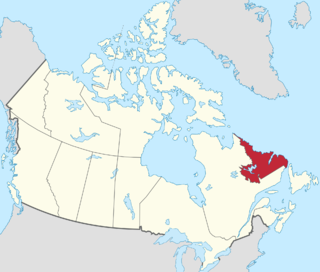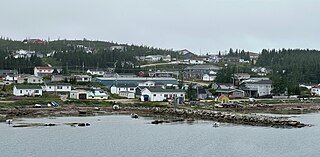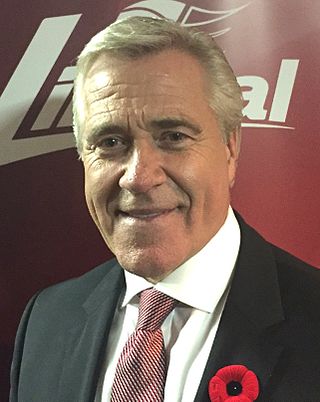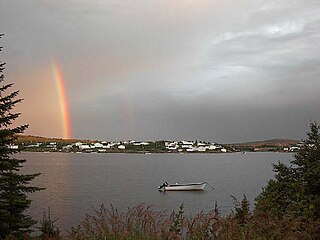Related Research Articles

Labrador is a geographic and cultural region within the Canadian province of Newfoundland and Labrador. It is the primarily continental portion of the province and constitutes 71% of the province's area but is home to only 6% of its population. It is separated from the island of Newfoundland by the Strait of Belle Isle. It is the largest and northernmost geographical region in the four Atlantic provinces.

Nunatsiavut is an autonomous area claimed by the Inuit in Newfoundland and Labrador, Canada. The settlement area includes territory in Labrador extending to the Quebec border. In 2002, the Labrador Inuit Association submitted a proposal for limited autonomy to the government of Newfoundland and Labrador. The constitution was ratified on December 1, 2005, at which time the Labrador Inuit Association ceased to exist, and the new Government of Nunatsiavut was established, initially being responsible for health, education and cultural affairs. It is also responsible for setting and conducting elections, the first of which was executed in October 2006. An election for the ordinary members of the Nunatsiavut Assembly was held on May 4, 2010. Its incumbent president is Johannes Lampe who assumed office in 2016.

Lake Melville is an estuary of Hamilton Inlet on the Labrador coast of the Canadian province of Newfoundland and Labrador. Comprising 3,069 km2 (1,185 sq mi) and stretching 140 km (87 mi) inland to Happy Valley-Goose Bay, it forms part of the largest estuary in the province, primarily draining the Churchill River and Naskaupi River watersheds. Both Lake Melville and Hamilton Inlet are encircled by mountains, with primary settlements at Happy Valley-Goose Bay, North West River, and Sheshatshiu. It is the 46th largest lake globally.

Nain is the northernmost permanent settlement in the Canadian province of Newfoundland and Labrador, within the Nunatsiavut region, located about 370 km (230 mi) by air from Happy Valley-Goose Bay. The town was established as a Moravian mission in 1771 by Jens Haven and other missionaries. As of 2021, the population is 1,204 mostly Inuit and mixed Inuit-European. Nain is the administrative capital of the autonomous region of Nunatsiavut.

Hopedale is a town located in the north of Labrador, the mainland portion of the Canadian province of Newfoundland and Labrador. Hopedale is the legislative capital of the Inuit Land Claims Area Nunatsiavut, and where the Nunatsiavut Assembly meets. As of the 2021 census, it has a population of 596.

Cartwright is a community located on the eastern side of the entrance to Sandwich Bay, along the southern coast of Labrador in the province of Newfoundland and Labrador, Canada. It was incorporated in 1956.

Rigolet is a remote, coastal Labrador community established in 1735 by French-Canadian trader Louis Fornel. The town is the southernmost officially recognized Inuit community in the world. Located on Hamilton Inlet, which is at the entrance to fresh water Lake Melville; Rigolet is on salt water and is accessible to navigation during the winter. Although there is no road access, the community is accessible by snowmobile trail, the Rigolet Airport, or seasonally via a coastal ferry from Happy Valley-Goose Bay.

Sheshatshiu is an Innu federal reserve and designated place in the Canadian province of Newfoundland and Labrador. The reserve is approximately 40 kilometres (25 mi) north of Happy Valley-Goose Bay. Some references may spell the community's name as Sheshatshit, the t spelling is more traditional in the Innu-aimun language, but the u is used more commonly in English to avoid inappropriate connotations. The name means "a narrow place in the river".

Postville is an Inuit town in the north of Labrador, Canada. It had a population of 188 as of 2021. It is located about 40 km (25 mi) inside Kaipokok Bay, 180 km (110 mi) NNE of Happy Valley-Goose Bay. Postville Airport is nearby.

Makkovik is a town in Labrador in eastern Canada. It had 365 residents in 2021. The main industry is snow crabbing and there is a fishing cooperative.
Churchill Falls is a community in the province of Newfoundland and Labrador, Canada. It is home to the Churchill Falls Generating Station and is a company town.
Muskrat Falls was a natural 15-metre (49 ft) waterfall located on the Churchill River about 25 kilometres (16 mi) west of Happy Valley-Goose Bay, Labrador.

Dwight Ball is a Canadian politician who was the 13th premier of Newfoundland and Labrador from 14 December 2015, to 19 August 2020, and an MHA. He represented the electoral district of Humber Valley in the Newfoundland and Labrador House of Assembly, and was the leader of the Liberal Party from 17 November 2013 to 3 August 2020.
Elizabeth Goudie was an Inuit Canadian writer. Her sole work, Woman of Labrador (ISBN 0-88778-116-0) was published in 1973.

Nalcor Energy was an energy corporation which headquartered in St. John's, Newfoundland and Labrador. A provincial Crown corporation under the Government of Newfoundland and Labrador, Nalcor Energy was created in 2007 to manage the province's energy resources.

The Churchill Falls Generating Station is a hydroelectric underground power station in Labrador. At 5,428 MW, it is the sixteenth largest in the world, and the second-largest in Canada, after the Robert-Bourassa generating station in northwestern Quebec.
The Muskrat Falls Generating Station is a hydroelectric generating station in the Labrador region of Newfoundland and Labrador, Canada. It comprises part of the remaining 35 per cent of the Churchill River that was not developed by the Churchill Falls Generating Station. The station at Muskrat Falls has a capacity of over 824 MW and provides 4.5 TWh of electricity per year.
Randy Edmunds is a Canadian politician in Newfoundland and Labrador. He was elected to the Newfoundland and Labrador House of Assembly in the 2011 provincial election. A member of the Liberal Party of Newfoundland and Labrador, he represented the electoral district of Torngat Mountains until 2019.

NunatuKavut is an Inuit territory in Labrador. It is unrecognized by other Indigenous groups in Canada, including the Innu Nation, the Nunatsiavut government, and the Inuit Tapiriit Kanatami. The NunatuKavummiut claim to be the direct descendants of the Inuit that lived south of the Churchill or Grand River prior to European contact, with recent European admixture primarily from English settlers. Despite claims of Inuit heritage, according to recent censuses completed by Statistics Canada, the vast majority of individuals living in communities that NunatuKavut claims are within its region continue to identify as Métis as opposed to 'Inuit'.

The Nunatsiavut Assembly is the legislative branch of the government of Nunatsiavut, Canada.
References
- ↑ "Division No. 10, Subd. C, Subdivision of unorganized (SNO)More information: Newfoundland and Labrador [Census subdivision]". Newfoundland & Labrador Statistics Agency. April 2023.
- ↑ "Woman of Labrador - Inuit Literatures ᐃᓄᐃᑦ ᐊᓪᓚᒍᓯᖏᑦ Littératures inuites". inuit.uqam.ca. Retrieved 2020-11-22.
- ↑ Breen, Katie (2017-06-01). "Mud Lake flooding victims prepare to launch class action suit". CBC News.
- ↑ Parker, Jacob (2017-06-02). "Mud Lake residents find temporary quarters in air force barracks". CBC News.
- ↑ "'People want to go back. But I'll never': Displaced Mud Lake woman wonders what's next". CBC News. Dec 13, 2017. Retrieved Oct 20, 2020.
- ↑ "Natural causes to blame for Mud Lake flooding, concludes independent report". CBC News. Oct 2, 2017. Retrieved Oct 20, 2020.
- ↑ "Class action against Nalcor, N.L. government for Mud Lake damage going ahead". CBC News. Jul 12, 2019. Retrieved Oct 20, 2020.
53°18′20″N60°10′01″W / 53.30556°N 60.16694°W